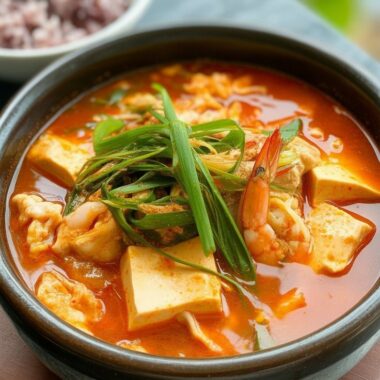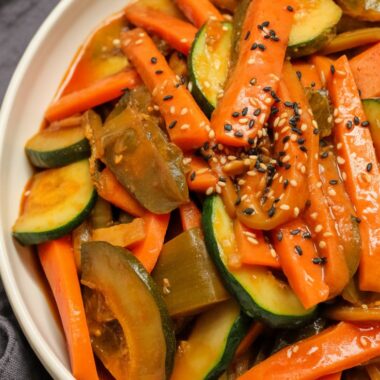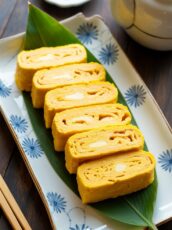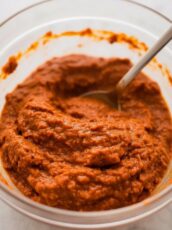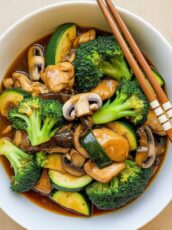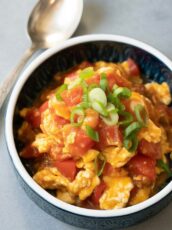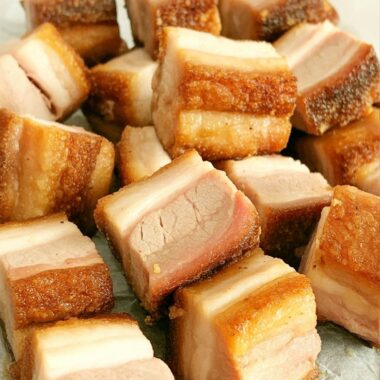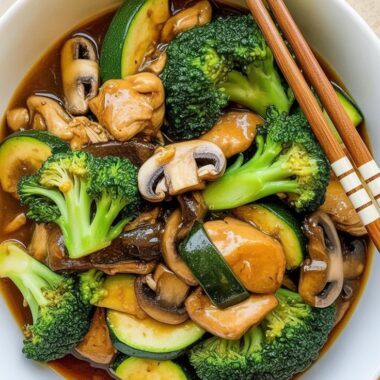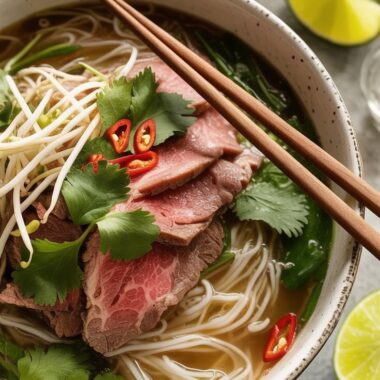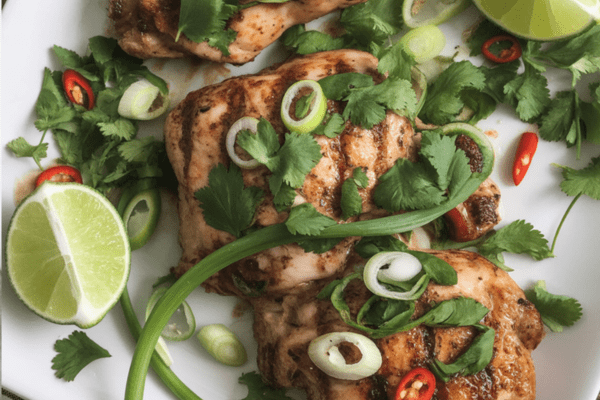I don’t say this lightly—this homemade beef pho might just be my favorite thing to make on a slow Sunday. There’s something incredibly comforting about letting a pot of spiced broth bubble away while the whole house slowly fills with the aroma of star anise, cinnamon, and ginger. It’s the kind of dish that wraps around you like a warm blanket and lingers in your memory long after the last slurp.
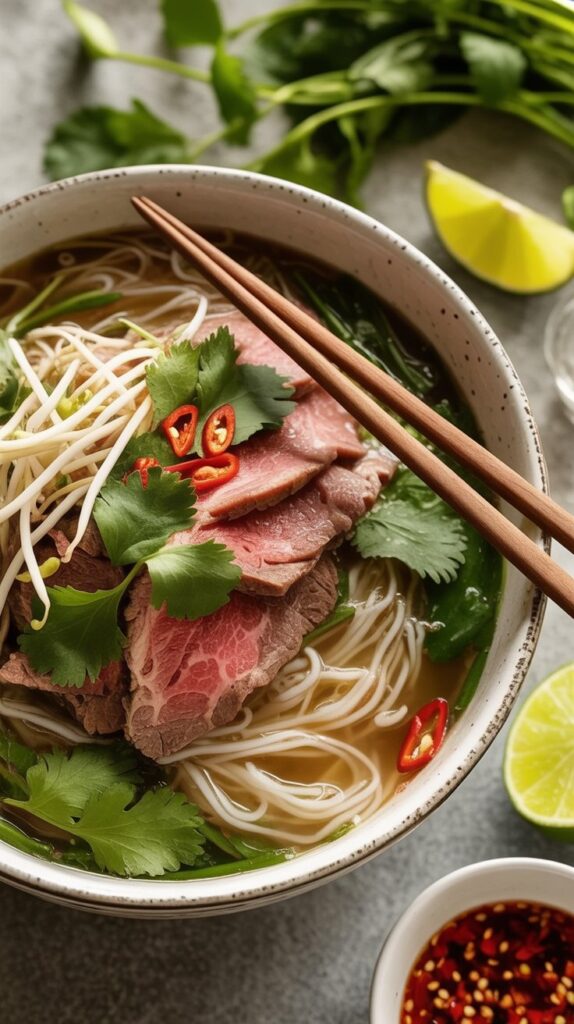
Why This Pho Is Worth Making
If you’ve ever had a really good bowl of pho—like, the kind that makes you stop mid-bite—you’ll know why I say it’s more than just noodle soup. It’s soul food. And while I’ve had my fair share of bowls from cozy Vietnamese joints, especially back when I lived near a busy market in Kolkata, nothing quite compares to the satisfaction of ladling that broth yourself.
Yes, it takes time. Yes, it’s messy. But that’s exactly what makes it special. This broth is made from scratch, slow-simmered with love, and loaded with rich beef flavor and warm spices. It’s not hard, it just needs patience (and a big pot).
So, What Exactly Is Pho?
Pho (pronounced “fuh”) is a traditional Vietnamese noodle soup, usually made with beef bones, aromatics, and rice noodles, and served with thin slices of raw beef that cook in the hot broth. It looks unassuming, but don’t be fooled—the magic is all in that slow-simmered broth.
The first time I had pho was at a tiny roadside place run by an elderly couple who’d moved from Hanoi. Their soup was crystal clear, deeply savory, and had this quiet warmth that stayed with me. I couldn’t stop thinking about it for days. That’s when I realized—pho isn’t just food, it’s a feeling.
The Heart of It All: The Broth
Let’s be honest—the broth is where the magic happens. Store-bought stock might be fine for weekday soups, but for pho, it’s got to be homemade. You need that deep beefiness, a whisper of charred onion and ginger, and those toasted spices that quietly bloom as everything simmers.
Here’s what goes in:
- Beef bones and brisket: A mix of meaty bones, marrow bones, and a good chunk of brisket for flavor. I usually get mine from an Asian butcher—they’re affordable and full of character.
- Aromatics: Charred onion and ginger. I just throw them directly on the gas flame till they get nice and blackened. It’s messy, but worth it.
- Spices: Star anise, cinnamon sticks, cardamom pods, coriander seeds. Toast them dry for a minute to wake them up.
It simmers for hours, yes. But the process is slow and calming. I usually use that time to prep the toppings, clean the kitchen, or just enjoy the smell wafting through the house.
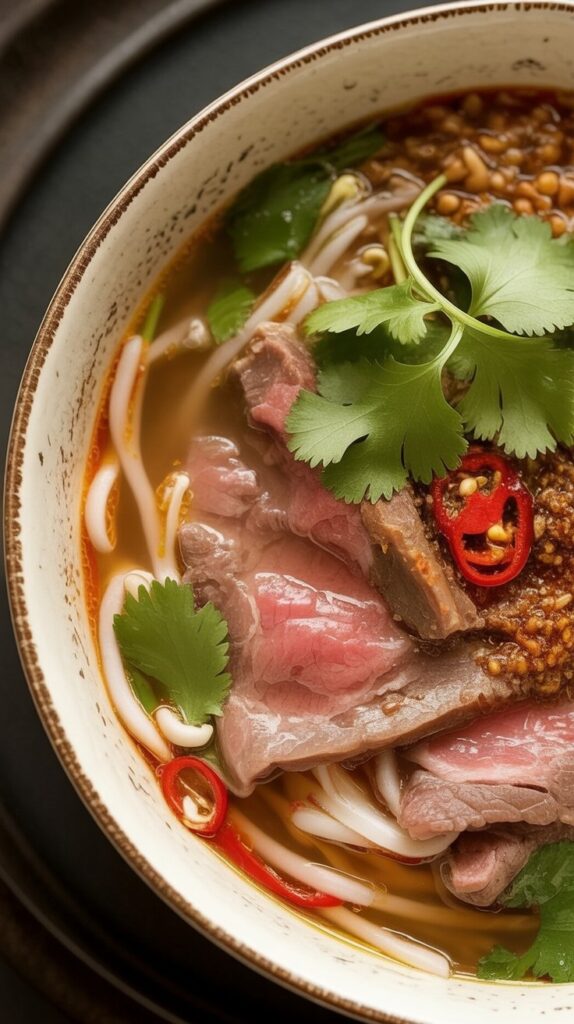
What Beef Cuts Work Best
I’ve tested this with just bones, and it always ends up… flat. Trust me, you need both bones and meat. I like using:
- Brisket – It’s flavorful and holds up to long simmering without falling apart.
- Marrow bones – For richness and body.
- Meaty soup bones – These add depth and that slightly gelatinous finish that makes pho broth feel luxurious.
If you can’t find brisket, chuck works too. And if your local butcher doesn’t carry marrow bones, try the freezer section at an Asian grocery.
The Spice and Smoke Magic
Here’s a little detail that really matters: char the onion and ginger before adding them. You want that hint of smokiness to peek through the broth. I just throw them on an open flame till they blister, but a broiler works too.
Also, toast the spices. It only takes a minute in a dry pan, but the difference it makes is huge.
These tiny steps give the broth that subtle, layered flavor that makes you go back for another spoonful… and then another.
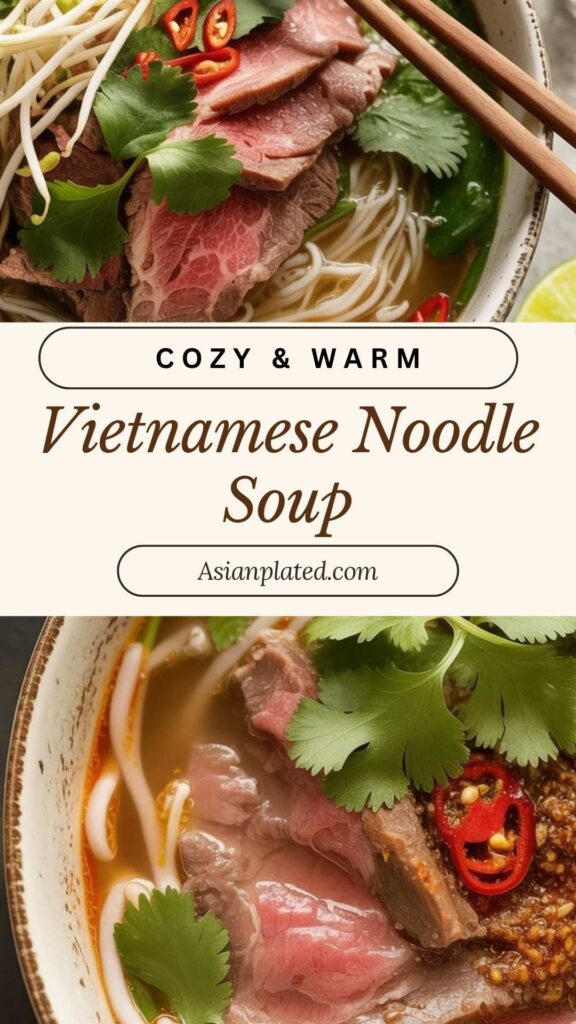
Serving Pho Like They Do in Hanoi
A good bowl of pho is all about contrast. Rich broth, soft noodles, tender beef, and a pile of fresh, crunchy toppings on the side. Here’s what I put out when I serve pho at home:
- Rice noodles – Fresh if I can find them, dry if not. Soak or boil just before serving.
- Raw beef slices – I use tenderloin. Freeze it slightly, then slice paper-thin. The hot broth will cook it to tender perfection in seconds.
- Brisket – From the broth. I slice it thin and layer a few pieces in each bowl.
- Toppings – Bean sprouts, Thai basil, coriander, lime wedges, chili slices, hoisin, and sriracha. Everyone builds their own bowl. It’s part of the fun.
And if someone doesn’t want raw beef in their soup? No problem—just dunk the slices in the broth for 10 seconds before serving.
Got Leftover Brisket? Lucky You.
You’ll have extra brisket from the broth—and that’s a good thing. It’s a little plain after simmering, but once shredded and pan-fried with garlic or hoisin or even butter, it’s magic.
Some of my favorite ways to use it:
- Shred it and pan-fry until crispy for rice bowls
- Toss with hoisin and sriracha for quick sliders
- Stir-fry it with noodles and veggies for a lazy weeknight dinner
- Make Vietnamese-style caramelized beef with a bit of fish sauce and sugar—amazing over jasmine rice
Is Making Pho at Home Worth It?
I think so, and here’s why:
- It’s cheaper – Making a big batch at home costs a fraction of restaurant pho.
- It freezes beautifully – I freeze the broth in mason jars and pull them out for rainy day lunches.
- It’s an experience – There’s something deeply satisfying about building this from the bones up. You’ll taste the difference.
- It feeds a crowd – Perfect for small gatherings or special family dinners.
And honestly? Sometimes I just enjoy the process. No pressure, no rush—just slow cooking and a house that smells incredible all day long.
If you’ve never made pho at home, I hope this gives you the confidence to try. It might take a little time, but every bowl is worth it. And if you do, make a little extra broth and freeze it—you’ll thank yourself next time you’re craving something cozy and soul-soothing.
Let me know how your pho turns out. And if you discover your own twist or topping combo that works, I’d love to hear about it.
Ready for the recipe? Scroll down and let’s get cooking.
Vietnamese Noodle Soup
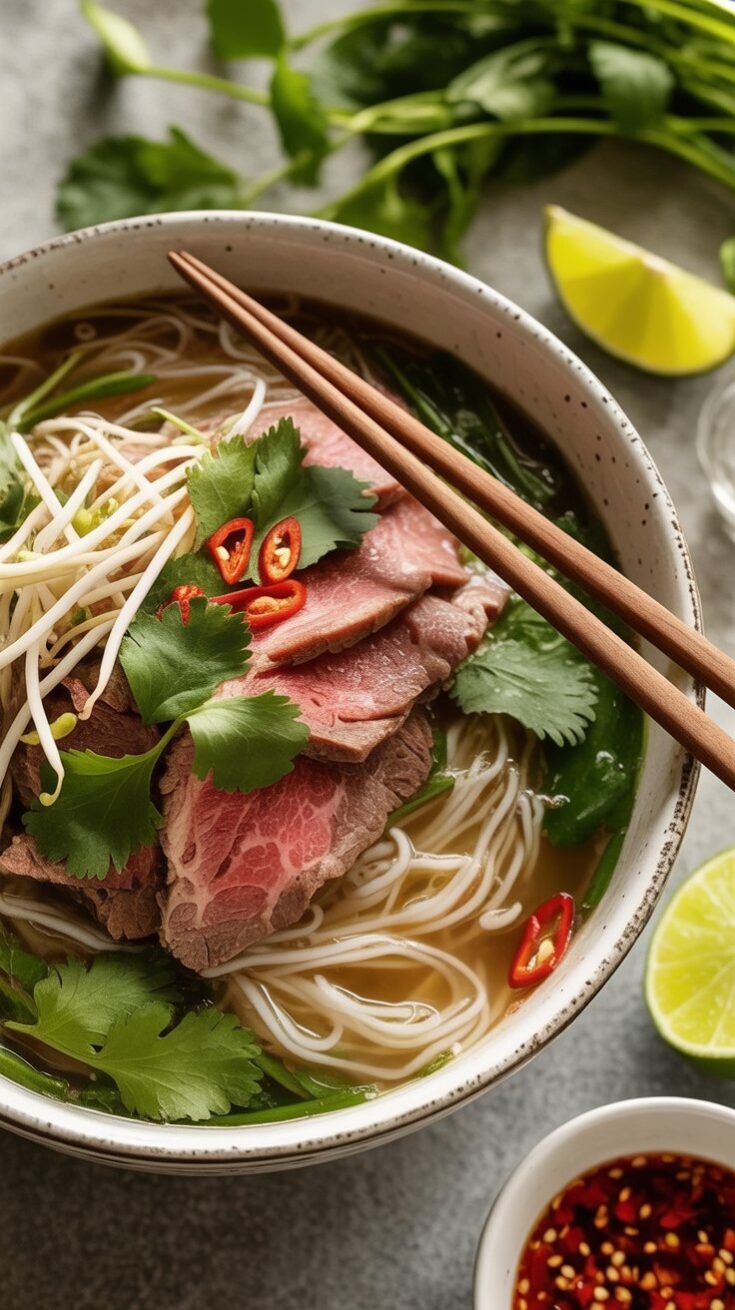
Vietnamese Pho is one of the world’s most celebrated noodle soups, renowned for its clear yet deeply flavorful beef broth infused with aromatic spices.
Ingredients
Aromatics:
- 2 large onions, halved
- 150g (5 oz) ginger, halved lengthwise
Spices:
- 10 star anise
- 4 cinnamon sticks
- 4 cardamom pods
- 3 whole cloves
- 1 ½ tablespoons coriander seeds
Beef and Bones:
- 1.5 kg (3 lb) beef brisket
- 1 kg (2 lb) meaty beef bones
- 1 kg (2 lb) marrow bones (leg or knuckle), cut to expose marrow
- 3.5 litres (15 cups) water
Seasoning:
- 2 tablespoons white sugar
- 1 tablespoon salt
- 3 tablespoons (40 ml) fish sauce
For Each Bowl:
- 50g (1.5 oz) dried rice noodles (or 120g fresh)
- 30g (1 oz) beef tenderloin, very thinly sliced
- 3–5 slices cooked brisket
Toppings:
- Handful of bean sprouts
- 3–5 sprigs Thai basil
- 3–5 sprigs coriander or extra basil
- Lime wedges
- Thinly sliced red chili
- Hoisin sauce
- Sriracha or other chili sauce
Instructions
- Char Aromatics: Heat a heavy skillet over high heat without oil until smoking. Place onions and ginger cut-side down and char until blackened, about a few minutes per side. Set aside.
- Toast Spices: Lightly toast star anise, cinnamon, cardamom, cloves, and coriander seeds in a dry pan over medium-high heat for 3 minutes until fragrant.
- Clean the Bones: Rinse bones and brisket. Place in a large pot, cover with water, and bring to a boil for 5 minutes. Drain and rinse bones and brisket under cold water to remove impurities.
- Make the Broth: Wipe the pot clean and add 3.5 litres fresh water. Add bones, brisket, charred onion and ginger, toasted spices, sugar, and salt. The water should just cover everything. Bring to a boil, then reduce to low heat and simmer covered for 3 hours.
- Remove Brisket: Take out the brisket once tender, cool and refrigerate for later use.
- Concentrate Broth: Simmer broth uncovered for another 40 minutes to deepen flavor.
- Strain: Strain broth through a fine sieve into a clean pot. Discard solids. Adjust seasoning with fish sauce, salt, and sugar to taste. The broth should be richly beefy, fragrant, and subtly sweet.
- Prepare Noodles: Cook rice noodles according to package instructions just before serving.
- Assemble Bowls: Divide noodles among bowls. Top with raw thinly sliced beef and cooked brisket. Ladle hot broth (about 400 ml per bowl) over to cook the raw beef to medium rare.
- Serve: Offer bean sprouts, herbs, lime, sliced chili, hoisin, and sriracha on the side to personalize each bowl.
Notes
- Brisket provides a deep beef flavor essential to the broth; it also serves as a tender meat topping. Substitute with boneless short ribs if necessary.
- Marrow bones add richness but minimal flavor; if unavailable, use more meaty bones.
- Fish sauce imparts umami; soy sauce can substitute but alters flavor slightly.
- Noodles: Medium-width flat rice noodles are ideal, avoiding vermicelli or wide varieties.
- Beef slices: Freeze tenderloin for 30 minutes before slicing very thin. Alternatively, briefly dip raw beef in hot broth to cook before eating.
- Leftover brisket can be repurposed into confiting, shredded beef dishes, stir-fries, or sandwiches.
Nutrition Information:
Yield: 6 Serving Size: 1Amount Per Serving: Calories: 1729Total Fat: 105gSaturated Fat: 41gTrans Fat: 0gUnsaturated Fat: 49gCholesterol: 576mgSodium: 1706mgCarbohydrates: 28gFiber: 4gSugar: 12gProtein: 160g
Asianplated.com, occasionally offers nutritional information for recipes contained on this site. This information is provided as a courtesy and is an estimate only. This information comes from online calculators. Although allchickenrecipes.com attempts to provide accurate nutritional information, these figures are only estimates.
Try other Vietnamese recipes:

